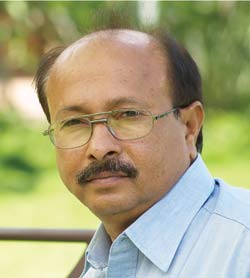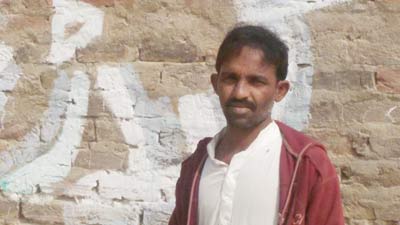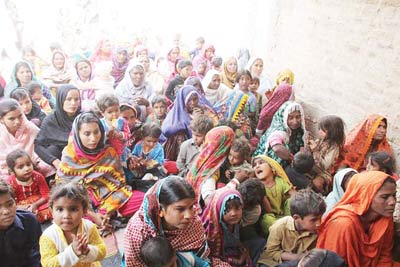Walking through the garbage strewn-filthy streets of the peasant camps, best known as Sikandarabad,
Walking through the garbage strewn-filthy streets of the peasant camps, best known as Sikandarabad, a heavily populated settlement in Kotri town, Jamshoro district, one may see the dilapidated state of the ‘freed’ bonded-labourers and their families.
The inhabitants of this settlement have been living without basic amenities for the past 18 years.
 The settlement, established in 1998, spreads over 22-acres of land. It was set up for accommodating the freed bonded labour families, who were rescued from brick kiln units and private jails in the agriculture fields.
The settlement, established in 1998, spreads over 22-acres of land. It was set up for accommodating the freed bonded labour families, who were rescued from brick kiln units and private jails in the agriculture fields.
Though a majority of these workers have changed hands from agriculture to industry, including construction work, they still lead a life filled with uncertainty.
Unsure of their survival, they live in perpetual fear of the land grabbers.
Reports gathered through community activists show that hundreds of families were rescued with the help of courts and police and the freed peasants were brought to this settlement to live according to their will. But they were soon threatened by land grabbers, who with the support of local administration, then bulldozed the fenced makeshift abodes, leaving the people vulnerable to face hardships and fear for a few months.
Though with government intervention, the people were again able to live on the state owned land, the threat of the land mafia still lurks around the corner for this marginalised community.
Amid the threat of losing their abode, the residents also suffer from lack of amenities and other basic facilities. A quick review reveals the area residents don’t have access to potable water, electricity, gas, or sanitation services.
The settlement lacks any government water supply infrastructure and the people have to buy it as a commodity. A small private tanker of 1,000 gallons of water costs the residents Rs800 for a single trip. This small quantity has to suffice for everything, from daily use to irrigation of the canals.
For lack of electricity, the people of Sikandarabad have found an alternative in the ‘kunda’ system. They have to pay Rs500 each month to get an illegal supply to light up their homes. Those who cannot afford to pay the amount for the illegal connection usually spend Rs10-20 daily to purchase candles or kerosene oil.
Similarly, each family has to pay Rs80-100 for purchasing fuel wood for their kitchens. Sanitation is another neglected service in the neighbourhood. So when it rains, the streets and lanes are flooded with sewage, putting the whole settlement at the risk of disease outbreaks.
Acute poverty, unemployment, low wages, and abusive treatment are common complaints faced by these people. Many families fearing threats to their lives have left the place.
Presently, local activists say there are more than 3,000 households in the settlement. About 200 families are those who were once rescued from bonded camps of landlords and brick kiln owners.
There are two sections in this locality. Majority of the families live in fenced makeshift abodes, while others have boundary walls for protection.
The people live without discrimination of religion, sect, tribes, faith, and ethnicity. There are Muslims, Hindus, Kolhis, Bheel, and Christians, who all live together harmoniously.
The settlement houses a few worship places as well that belong to the various faiths of the residents. All in all, the local activists and community workers say that despite poverty and the myriad economic problems, the people of Sikandarabad are helpful and supportive of each other and stay together in both good and bad.
Some of the elders in the community, who came to settle 18 years ago, have never returned to their old homes. Apart from many reasons, lack of resources is a major one for them. They cannot afford the cost of travelling to see their relatives and fear getting trapped again.
Changing hands
The dwellers of Hari Camp have various experiences. In the past, some worked on agricultural land while others worked in brick kilns. Now many of them have joined factories in the towns and surrounding industrial areas on daily wages.
Krimchi Kolhi, 75-year old peasant worker, has four sons, who work as daily wagers in a nearby factory. They earn a very little amount to support their family. Krimchi originally belongs to the famous green zone of Kasbo near Nagarparkar, Tharparkar district. His parents had moved to Naukot town long ago when a drought hit the area. He was only 10-12 years old at that time and studied in a primary school.
Krimchi tells how, after his parents moved from their native area with him and his three brothers, they joined an agriculture field. What followed was a chain of abuse, exploitation, and more poverty at the hands of landlords, he says.
“At last I was rescued from the landlord of Sanghar and shifted to this Hari Camp in 1998. I owned some family land, which my brothers sold out. Now I cannot even meet my own brothers’ families,” he explained.
Mannu Bheel also lives in this locality. Bheel hit headlines in all the local and national dailies after the Supreme Court's former chief justice took suo motu notice of his 1,287-day token hunger strike against the landlords, who had kidnapped his nine family members, including wife and children, who have not been recovered.
Maojee Kolhi is another peasant worker, who came from Tando Bago, Badin District where his entire family was forced to work to pay off the debt. He is the father of four sons, who work at a thread-mill nearby on daily wages.
Maojee does not know where he was born and from where he started his long journey, he simply said, "I always saw the similar green fields, worked day and nights with parents. I never have time and the reason to ask about the past, where we belong and why we left the area."
Rizwan Masih, lovingly known as “Geedar” in the neighbourhood, also has a similar tale to relate. He says he was born in the agriculture field near Mirpurkhas. He came here when he was 10 years old. He worked in different factories since childhood to ease the troubles of his family.
While most of those who were freed from the clutches of the landlords in rural areas due to the human rights organisations, some like Geedar think they have now been left at the mercy of urban landlords. He refers to the land grabbers who are forcing the poor to vacate the government owned land for minting money. “Several families have fled in fear, vacating their plots, which were sold by ‘certain’ people.”
He shows a ground, named Geeder Chowk in the centre of the settlement. This he says is used by the people to come together on happy occasions. It is also a symbol of resistance that these poor community people show against the builder mafia.
Geedar has a record of fighting with land grabbers, mobilising community people, facing police attacks, and approaching lawyers for help. He claims it is a long fight to save the poor families.
The law
Zulfiar Shah, Joint Director at Pakistan Institute of Labour Education and Research (PILER), asks the Sindh government to frame the bonded abolition act, as after the 18th Amendment, labour has become a provincial subject.
There are fears that about a million people, living as debt-slaves mostly in Sindh and southern Punjab need help. Punjab government has framed the bonded labour abolition act and is implementing to protect these oppressed segments of the society.
The same needs to be initiated in Sindh, where debt bondage is still practiced in many areas.
Though the bonded labour abolition act links freed families with rehabilitation measures and facilities, including security, potable water, electricity, schools for children, health facilities, and employment, practically, there are no initiatives. “There is no initiative so far to rehabilitate these people,” he added.
The writer is a staff member